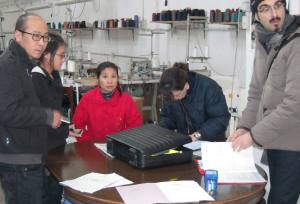Tuscan town turns against Chinese immigrants
By Guy Dinmore in Prato, Italy
 When the Italian police, firefighters and assorted inspectors banged on the factory door, launching their latest raid on illegal Chinese sweatshops in Prato, most of the stunned workers living there in damp, windowless cubicles were still in pyjamas.
When the Italian police, firefighters and assorted inspectors banged on the factory door, launching their latest raid on illegal Chinese sweatshops in Prato, most of the stunned workers living there in damp, windowless cubicles were still in pyjamas.
Within hours, four more clothing factories in Lazzeretto street had been sealed and ranks of sewing machines confiscated, two illegal immigrants were hauled off and the remaining few dozen workers told to get out.
After years of tolerating and also benefiting from waves of Chinese immigrants who have built the largest concentration of Chinese-run industry in Europe, the people of this ancient Tuscan city have decided enough is enough.
“The last drop sent the vase spilling over. The city cannot go on like this,” declared Riccardo Marini, president of Prato’s association of industrialists. “The Chinese may respect the laws in France and the UK but here they don’t because they were allowed to by a system of politicians and entrepreneurs. It got out of hand.”
Having voted for the left for 63 years, Prato swung to the centre-right and the xenophobic Northern League in municipal elections last June.
Roberto Cenni, the new mayor who is also a textile and clothing entrepreneur, denounces the “slave-like conditions” endured by low-paid Chinese workers. Backed by Roberto Maroni, the Northern League’s hardline interior minister, police last month launched a crackdown on illegal workshops. Helicopters buzzed overhead to carry the message.
His community in a state of shock, newspapers reported that China’s consul-general in nearby Florence compared the raids with the Nazi SS.
Proud of its centuries-old history in textiles but with its industry in decline, Prato sees itself as a victim of open borders and globalisation gone wild.
Mr Marini recalls the first group of 38 Chinese arriving in 1989 to work in textile factories. Now they are estimated to number up to 40,000, many of them illegal. One-third of the city’s 180,000 residents are non-Italian, compared with a national average of 6 per cent.
As Prato’s textile industry haemorrhaged jobs – unable to compete with cheaper cloth made in China – the Chinese community in Prato used their acquired skills to carve out a separate niche producing pronto moda or “fast fashion”.
Whereas a few years ago, many Chinese entered Italy illegally, now they simply arrive at Frankfurt airport on three-month tourist visas, but do not leave. Most in Prato come from just one Chinese city – coastal Wenzhou in Zhejiang province, an enclave with a history of entrepreneurs ready to cross the sea.
Outside Prato’s city walls, Via Pistoiese has become a Wenzhou Chinatown with restaurants, nightclubs (which bar non-Chinese) and supermarkets stocked with Chinese goods.
Silvia Pieraccini, a local journalist and author of The Chinese Siege , says the key to the Chinese success is twofold. Speed comes first. A factory in China needs two months to replicate the latest Milan-driven fashion and get cheap products on to the European market. In Prato, it takes two weeks and comes with the “Made in Italy” label.
Secondly, the Chinese have mastered the entire production chain. They import cheap Chinese cloth, then dye it and print the designs. Buttons, zips, beads are made locally. Finished items are sold to buyers from all over Europe who flock to wholesale outlets.
The starting price for a simple lady’s cotton shirt is €1.70 ($2.30, £1.50). At full output the estimated 3,500 Chinese factories in Prato can produce 1m items a day. The Chinese rely on creative Italian expertise in design, marketing and accounting.
But the combination of recession and crackdown is turning the tide against those illegal Chinese factories that do not pay taxes, union dues or city services. But what will happen next is unclear.
The mayor – whose Sasch clothing chain produces and sells in China – wants the Chinese manufacturers in Prato to use the city’s own high-quality textiles rather than imported cloth, and even sell back to China.
It is uncertain whether Chinese bosses will turn legal and thus less competitive, or shift production elsewhere.
One big frustration for police is that they cannot deport illegal immigrants who have no documents, because China refuses to accept them back. Only two were deported last year. “We are dealing with a China without borders,” says Mr Marini.
In China the crackdown has gone largely unreported with state media instructed not to go to Prato. Sun Yuxi, China’s ambassador to Rome, stresses the Chinese contribution to Prato’s “wealth”, insisting that only a small minority of workers are illegal.
Sitting forlornly in her pyjamas as police raided the Lola sweatshop, one 23-year-old worker said the recession was so bad they had hardly worked since October. She would like to go home but cannot do so empty-handed.
Material world
*Prato’s population is about 180,000, of whom one-third are immigrants (compared to a national average of 6 per cent) *Some 35,000-40,000 Chinese live in Prato*The Italian textile sector has lost nearly 11,000 jobs since 2000. It now employs 20,200 *Textile production has fallen from €4bn in 2000 to about €2.7bn in 2009 *About 4,200 Chinese companies are registered in Prato, of which 75 per cent are garment manufacturers producing up to 1m items a day*At this rate, it is said the Chinese garment makers of Prato could dress the world’s population in 20 years
Sources: Prato municipal officials; local union of industrialists
-
October 8, 2010 at 9:43 amLa Pechino d'Italia | Lo Spazio della Politica